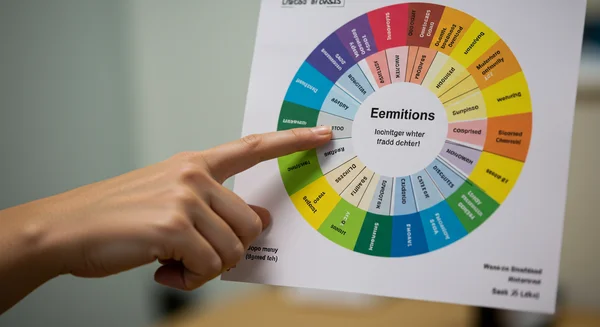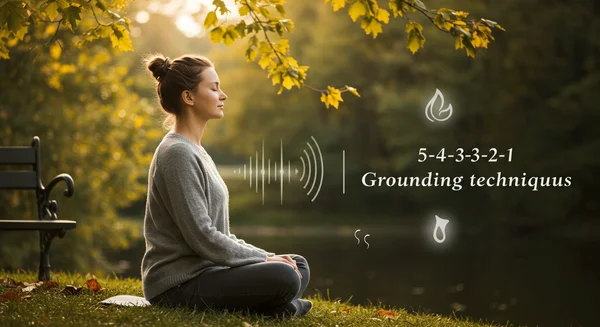述情障碍测试与应对机制:提升情绪素养
你是否曾在情绪世界中感到迷失,难以识别或表达自己的感受?这种迷失感出乎意料地普遍,并可能导致深深的挫败感和孤独感。许多人会不禁自问:“ 我为什么这么不擅长表达自己的感受? ” 如果这个问题引起了你的共鸣,那么你来对地方了。本文将指导你了解实用的 述情障碍应对机制 和练习,以提升你的情绪素养。通过培养这些技能,你可以更深入地与自己和他人建立联系。踏上这段旅程的第一步是,通过 在线述情障碍测试 了解你自己的情绪特点。

了解情绪素养和述情障碍
在深入探讨解决方案之前,了解我们正在处理的概念至关重要。情绪素养是指识别、理解、标注和表达我们情绪的能力。而述情障碍则描述了在这些方面存在困难。它不是性格缺陷,而是一个人在处理情绪时的一种特定特质。培养自我意识是管理这些特质的基石。
什么是述情障碍?超越情感麻木
什么是述情障碍 常常被误解为简单的情绪麻木或缺乏关心,但它远比这更为细致入微。这个词字面意思是“缺乏表达情感的词汇”。具有高述情障碍特质的人会感受到情绪,但他们难以将这些身体感受与特定的情绪标签(如“悲伤”、“愤怒”或“喜悦”)联系起来。他们可能会经历心跳加速或胃部打结,却无法将其识别为焦虑。这与冷漠不同;感受是存在的,但理解缺失了。认识到这种区别是个人成长的关键部分。
为什么情绪素养对管理述情障碍特质很重要
将情绪素养视为连接内在感受和意识理解的关键桥梁。如果你是具有述情障碍特质的人,建造这座桥梁可以真正带来变革。它能让你将令人困惑的身体信号转化为关于你的需求、界限和愿望的有价值的信息。提升这项技能可以减轻压力,增强决策能力,并加深你的人际关系。当你能够说“我感到不知所措”而不是仅仅感到一种模糊、不舒服的紧张时,你就可以采取措施解决根本原因,这是一种强大的 述情障碍自助 形式。
实用的情绪素养练习
培养情绪意识就像锻炼肌肉一样——需要持续的练习。以下 情绪素养练习 旨在简单、有效且易于融入你的日常生活。它们帮助你调谐到你的内在世界,并开始为你的经历建立词汇。
识别感受:身体扫描法
最有效的 情绪识别技巧 之一是身体扫描。由于情绪通常首先表现为身体感受,这项练习有助于你重新建立身心连接。
- 找一个安静的空间:舒适地坐下或躺下,闭上眼睛。
- 专注于呼吸:做几次缓慢而深长的呼吸来集中自己。
- 扫描身体:将注意力集中在头顶,然后慢慢向下移动到脚趾。不带评判地注意任何感受。你的下巴是否紧绷?胸部是否有颤动?手部是否温暖?
- 连接到一种感受:不要仅仅是注意到这种感觉,而是轻轻地问自己,可能与它相关的感受是什么。胸部紧绷可能是焦虑,而温暖的感觉可能是满足。不要强迫自己给出答案;只需探索可能性。
命名情绪:扩展你的情感词汇
难以命名情绪是述情障碍的核心特征。你可以通过扩展你的情绪词汇来积极改善这一点。
-
使用情绪轮:在线搜索“情绪轮”。这个工具直观地展示了广泛的感受,从“悲伤”等基本情绪到“忧郁”或“失望”等更细微的情绪。
-
全天进行标注:在一天中的不同时间点,停下来尝试使用情绪轮来标注你当前的状态。一开始,你可能只能识别基本情绪。随着时间的推移,你将变得更擅长准确地指出具体情绪。这种练习直接提升了你 表达感受 的能力。

探索诱因:写日记以应对述情障碍的力量
写日记以应对述情障碍 是一个宝贵的自我反思工具。它创造了一个安全的空间,用于探索事件与你的内在反应之间的联系。
- 关注事实:一开始不要担心描述感受。只需写下在某个情境中发生了什么以及你身体的感受。例如:“会议期间,老板给了我额外的工作。我注意到我的肩膀绷紧了,胃部感到紧缩。”
- 寻找模式:随着时间的推移,回顾你的日记。你可能会注意到,每当你感到压力时,你的肩膀总是会绷紧,或者当你感到不确定时,你的胃部会紧缩。这些模式是连接外部事件与你内在状态的线索,有助于提升情绪意识。你可以通过一个简单的评估 开始你的探索之旅。
情绪调节和表达的策略
一旦你开始识别自己的情绪,下一步就是学习管理和表达它们。这些策略提供了处理情绪而不至于不知所措,并与他人分享你的内心世界的实用方法。这是有效使用 述情障碍应对机制 的关键方面。
沟通你的内在世界:简单的短语和视觉表达
如果难以找到合适的词语,你不必从复杂的深入情感描述开始。
- 使用侧重于身体感受的“我感到”句式:与其说“我很生气”,不如从“我感到胸口发热、紧绷”开始。这是对你体验的诚实而准确的表达。
- 使用隐喻或视觉表达:有时,一幅画胜过千言万语。你可以说,“我的思绪像波涛汹涌的大海”,或者“我感觉像背负着沉重的负担”。这可能是一种更易于表达你状态的方式,尤其是在讨论 述情障碍与爱 时。
应对强烈情绪:安定技巧
当一种情绪变得难以承受时, 安定技巧 可以让你回到当下,并减轻情绪的强度。5-4-3-2-1 方法是一个受欢迎的选择:
-
5:说出你周围能看到的五样东西。
-
4:承认你能触摸到的四样东西。
-
3:聆听你能听到的三样声音。
-
2:识别你能闻到的两样气味。
-
1:说出你能尝到的一样味道。 这项练习将你的注意力从强烈的内心风暴中拉开,并帮助你稳定在你的即时环境中,这是 情绪调节 的关键部分。

培养临在感:正念在述情障碍中的应用
正念在述情障碍中的应用 的练习涉及不带评判地关注当下。这是一项长期的策略,它为情绪意识打下了基础。简单的正念练习,比如每天专注于呼吸五分钟,可以训练你的大脑更敏锐地感知情绪和身体状态的细微变化。这种临在感让你在需要时更容易运用其他应对技能。
建立长期的述情障碍自助习惯
提升情绪素养是一场马拉松,而非短跑。持之以恒是关键。通过将这些练习融入你的生活,你正在建立可持续的习惯,这些习惯将在未来多年促进你的情绪健康。
寻求支持:何时考虑专业指导
虽然自助策略很有力,但有时也需要专业指导。如果你感到停滞不前、不知所措,或者认为述情障碍特质正在严重影响你的生活和人际关系,寻求 述情障碍治疗 会很有益。专门从事认知行为疗法(CBT)或躯体疗法的治疗师可以提供系统化的工具和支持。初步步骤可以是 获取你的结果,来自在线述情障碍测试,并与专业人士分享。

庆祝小胜利:一段自我发现的旅程
请记住对自己保持耐心和慈悲。每一次你成功地识别出一种身体感受、标注一种情绪,或表达你的内在状态,都是一次胜利。认可你的进步。这段旅程不是为了“修复”一个缺陷,而是为了踏上一条深刻的自我发现之路,并发展出更丰富、更紧密相连的生活。
你的情绪理解之路
当你具有述情障碍特质时,探索你的内心世界可能充满挑战,但这绝非不可能。通过练习情绪素养练习,使用有效的情绪调节应对机制,并建立长期的自助习惯,你可以与自己的感受建立更强的联系。这段旅程将赋予你力量,建立更有意义的人际关系,并过上更充实的生活。
准备好迈出了解你情绪世界的第一步了吗?立即 参加免费的述情障碍测试。获取即时分数以了解你的状况,或者选择我们独特的 AI 个性化报告,以获取深入的见解和为你量身定制的可行计划。
关于述情障碍和情绪成长的常见问题
述情障碍可以通过自助改善吗? 当然可以。虽然述情障碍是一种根深蒂固的特质,但持续练习写日记、身体扫描和正念等自助策略可以显著提高情绪意识和表达能力。关键在于持续的努力和对过程的耐心。
我如何知道自己是否有述情障碍特质? 常见的迹象包括难以识别感受、难以区分情绪和身体感受,以及向他人描述感受的能力有限。最可靠的初步评估方法是进行结构化评估。我们网站上提供的在线 述情障碍测试,如 OAQG2 测试,可以提供有价值的见解。
述情障碍患者会生气吗? 是的,述情障碍患者会体验愤怒和其他情绪。挑战在于识别并标注这种感受为“愤怒”。他们可能会感受到身体上的迹象——脸红、握紧拳头、心跳加速——但却难以将其与愤怒的情绪概念联系起来,常常将其描述为只是身体上的烦躁或不适。
我为什么这么不擅长表达自己的感受? 这可能源于许多因素,包括你的成长经历、过去的创伤,或自闭症中发现的神经多样性特质。述情障碍是导致这种困难的一个具体原因。通过 免费自我评估 等工具进一步探索这个问题,可以提供清晰度并为改善提供起点。